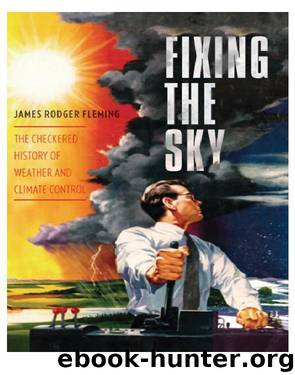Fixing the Sky by James Rodger Fleming

Author:James Rodger Fleming
Language: eng
Format: epub, mobi
Publisher: Columbia University Press
Published: 2011-02-20T16:00:00+00:00
Commercial Cloud Seeding
While researchers were struggling for verifiable results, an uncritical, determined, and enthusiastic band of private meteorological entrepreneurs, operating primarily in the West and Midwest, had appropriated the new technology and succeeded in placing nearly 10 percent of the land area of the country under commercial cloud seeding. The annual cost of this plan to farmers and municipal water districts was $3 million to $5 million. The spread of this practice generated numerous public controversies that pitted weather control entrepreneurs and their clients against weather bureau officials. Third parties often claimed damages purportedly caused by cloud seeding. In 1951, for example, New York City was facing 169 claims totaling more than $2 million from Catskill communities and citizens for flooding and other damages attributed to the activities of a private rainmaker, Dr. Wallace E. Howell. The city had hired Howell to fill its reservoirs and, at least initially, claimed that Howell had succeeded. When faced with the lawsuits, however, city officials reversed their position and commissioned a survey to show that the seeding was ineffective. Although the plaintiffs were not awarded damages, they did win a permanent injunction against New York City, which terminated further cloud-seeding activities; further litigation stopped just short of the Supreme Court. As discussed earlier, this prompted Colonel John Stingo to comment on the incivility of it all.75
“State Farmers Wage Fight For, Against Rain,” reported the Seattle Times on June 14, 1952: “Cloud formations moving toward the Yakima and Wenatchee Valleys are being bombarded daily in secret, opposing experiments financed by wheat-growers who want rain and fruit growers who don’t. One set of attacks is designed to punch holes in the clouds to bring rain. The other seeks to disperse the clouds without rainfall.” Both “wet” and “dry” campaigns were being waged with competing ground-based silver iodide generators. One array was deployed by the Water Resources Corporation of Denver, which was attempting to make rain for the wheat growers; the other array, deployed by Olympia meteorologist Jack M. Hubbard, was run continuously to “overseed” the clouds and ward off rain for the fruit growers—a domestic version of cloud wars (figure 5.4).
Download
This site does not store any files on its server. We only index and link to content provided by other sites. Please contact the content providers to delete copyright contents if any and email us, we'll remove relevant links or contents immediately.
The Secret History by Donna Tartt(18951)
The Social Justice Warrior Handbook by Lisa De Pasquale(12170)
Thirteen Reasons Why by Jay Asher(8849)
This Is How You Lose Her by Junot Diaz(6837)
Weapons of Math Destruction by Cathy O'Neil(6220)
Zero to One by Peter Thiel(5736)
Beartown by Fredrik Backman(5682)
The Myth of the Strong Leader by Archie Brown(5463)
The Fire Next Time by James Baldwin(5386)
How Democracies Die by Steven Levitsky & Daniel Ziblatt(5175)
Promise Me, Dad by Joe Biden(5117)
Stone's Rules by Roger Stone(5053)
A Higher Loyalty: Truth, Lies, and Leadership by James Comey(4909)
100 Deadly Skills by Clint Emerson(4882)
Rise and Kill First by Ronen Bergman(4741)
Secrecy World by Jake Bernstein(4703)
The David Icke Guide to the Global Conspiracy (and how to end it) by David Icke(4659)
The Farm by Tom Rob Smith(4468)
The Doomsday Machine by Daniel Ellsberg(4452)
